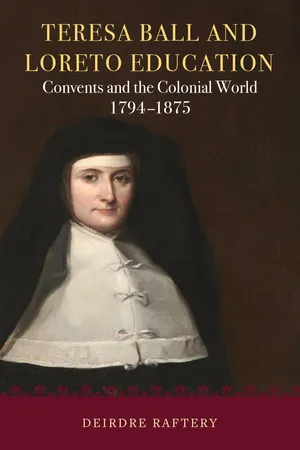
Teresa Ball and Loreto Education
Convents and the colonial world, 1794-1875
- 229 pages
- English
- PDF
- Available on iOS & Android
About this book
Educated at the Bar Convent, York, Teresa Ball became a pioneer of girls' education when she returned to Ireland, opening Loreto Abbey convent and boarding school in 1822. The Dublin convent quickly attracted the daughters of the Irish elite, not only as pupils but also as postulants and novices. The rapid expansion of Loreto convents in Ireland helped to provide a supply of nuns who founded a network of Loreto convents in nineteenth-century India, Mauritius, Gibraltar, Canada, England, Spain and Australia. This book commences with an original and important study of the Balls and their social world in Dublin at the start of the nineteenth century. Their network included members of the Catholic Committee, the Catholic Church hierarchy, and many benevolent public figures. The book gives new insight into how women operated in the margins of this Catholic world. The education of the Ball children, at York and Stonyhurst, positioned them for success in Catholic society, at a time when the confidence of their Church was growing in Ireland. The youngest of the Ball children was professed as a nun in 1816, in the York convent of the Institute of the Blessed Virgin Mary (IBVM), and returned to Dublin as Mother Teresa Ball, in 1821. With the encouragement of Dr Daniel Murray, Teresa Ball established the IBVM at Loreto Abbey, Rathfarnham, in 1822. The convent educated the elite, and also attracted the daughters of the growing Catholic middle class. The book draws on extensive archival records, to reconstruct the history of the convent, showing how it became the 'motherhouse' to Loreto convents around the globe. The international network of Loreto convents expanded quickly in the nineteenth century, providing schooling for the Catholic colonial world. How did Teresa Ball prepare her nuns to negotiate this world? Where did they go, and what kind of distinctive 'Loreto education' did they bring with them? The book answers these questions, while also providing a new and important account of global Catholic schooling, and some of the Irish women behind it.
Frequently asked questions
- Essential is ideal for learners and professionals who enjoy exploring a wide range of subjects. Access the Essential Library with 800,000+ trusted titles and best-sellers across business, personal growth, and the humanities. Includes unlimited reading time and Standard Read Aloud voice.
- Complete: Perfect for advanced learners and researchers needing full, unrestricted access. Unlock 1.4M+ books across hundreds of subjects, including academic and specialized titles. The Complete Plan also includes advanced features like Premium Read Aloud and Research Assistant.
Please note we cannot support devices running on iOS 13 and Android 7 or earlier. Learn more about using the app.
Information
Table of contents
- Cover
- Dedication
- Title page
- Copyright page
- Table of contents
- Acknowledgments
- Family trees
- List of illustrations
- List of abbreviations
- Preface
- 1. The Ball family and life in Georgian Dublin
- 2. York, Cork and Stonyhurst: schooling and the Ball family
- 3. Return to Ireland: marriages and friendships
- 4. The formation of a foundress
- 5. Transplanting the ‘English Ladies’ to Ireland: thefoundation at Rathfarnham
- Plates
- 6. Irish Loreto convents in the age of empire
- 7. Loreto foundations and the colonial project
- 8. From global expansion to untimely death
- Appendix A: Irish-born students attending the Bar Convent,1710‒1886
- Appendix B: First members of the Institute of the Blessed Virgin Mary, Ireland, 1814‒40
- Bibliography
- Index